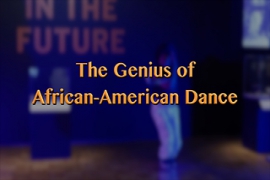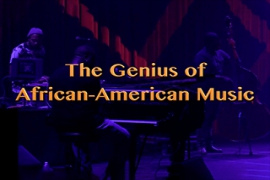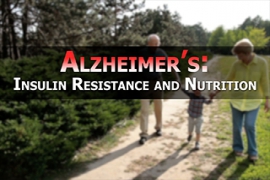Miracle of the Human Body
- Title ID 60-MHB
- Science, Biology, Core Science, Medicine, Nursing
- 8 Programs
- 17 Supplemental Files
- 10th Grade through Post Secondary
- Published by Ambrose Video Publishing Inc./Centre Communications

Included Programs
Miracle of the Human Body: The Skeletal System Running time is 29 minutes
Chapter List
- Introduction
- Humans are vertebrates with a unique shape.
- Spine
- The spine or the backbone is made up of vertebrae, vertebral bodies, which protect the spinal cord, and there are five regions - cervical, thorax, the thoracic spine or thoracic vertebrae, lumbar spine, sacrum and coccyx.
- Bones
- Human bones come in many shapes and sizes and include the longest and strongest, the leg bones, made up of the femur or thigh bone, the tibia and fibula, ankle and foot bones, made up of the tarsals, meta tarsals and phalanges, and wrist and hand bones made up of carpals, meta carpals and phalanges.
- Bone Composition
- The bone composition which includes a the cortical layer and the bone shaft , makes bones an engineering marvel.
- Protective Function of Bone
- Bones also serve a protective function, such as the rib cage and sternum, or breast bone, which protect the heart and lungs.
- Pelvis Anatomy
- The pelvis, or hips, in either a male or female is a ring of bones connecting the two femurs, or femural heads, to the spine, and at the same time it protects the pelvic organs through its large bones and pubic symphysis.
- Skull
- There are many kinds of bone joints - pivot joints, ball and socket joints, hinge joints, such as the knee with its patella, anterior and posterior cruciate ligaments, and gliding joints.
- Bone Joints
- Cartilage helps joints to slide and protects joints from getting arthritis.
- Cartilage
- Bone diseases include arthritis and osteo arthritis which are inflammations of the bones, and bone degenerative problems that can lead to such surgeries as hip replacement.
- Bone Diseases
- Bone diseases include arthritis and osteo arthritis which are inflammations of the bones, and bone degenerative problems that can lead to such surgeries as hip replacement.
- The Living Bone
- The living bone is made up of connective tissue, blood vessels a rich mineral layer known as cortical bone, spongy bone and bone marrow which is a blood factory producing blood cells for the body..
- Conclusion
- The human skeleton is a brilliantly functional system that gives humans their basic body plan.
Miracle of the Human Body: The Muscular SystemRunning time is 29 minutes
Chapter List
- Introduction
- This is an introduction to muscles and how they move the bones of the skeleton and animate the body.
- Lever Principle
- Muscles work by the lever principle, like a teeter totter plank on a fulcrum, so that the bones are the rods or planks, the joints are the pivot points or the fulcrums and muscles supply the force, and there are first class, second class and third class levers with the muscles working in pairs.
- Muscle and Bone Anatomy
- Using the knee joint and the patella, we can see how muscles and bones work together, with the powerful hamstring muscles and the quadriceps muscles making a third class lever; and by moving onto the arm we see this also in the radius is connected by the bicep muscle and the ulna and humerus bones are connected by the tricep muscles.
- Muscle Chemistry
- Muscles need energy to work and they use chemical energy stored as glycogen - a form of sugar - which is converted in the muscles cells with ATP adenosine triphosphate.
- How Muscles Work
- Muscle are made up of two kinds of muscle fibers - actin filaments and myosin filaments, which work together to make muscles contract.
- Muscular Anatomy and Physiology
- This chapter looks at the different kinds of muscles from the head to the feet, including the masseter or jaw muscle, the trapezius which rotates the shoulder blade, the pectoral muscles, the deltoids, intercostals, latissimus dorsi, abdominal obliques, gluteus maximus, hamstrings, and gastrocnemius and soleus or calf muscles.
- Tendons, Ligaments and Fascia
- Tendons are part of the skeletal muscles and are made up of tenocytes and collagen proteins, while ligaments are composed of collagen fibers and fascia connects skin to muscles and deep fascia covers the muscles and organs.
- Knee Anatomy
- In dissecting the knee, we see quadriceps muscles inserting into a tendon that inserts into the patella which articulates with the femur, as well as the anterior cruciate ligament and the posterior cruciate ligament.
- Muscle Disease
- Muscle diseases can be common complaints such as tennis elbow or something more serious such as a rupture of the Achilles tendon which is attached between the ankle and the calf or gastrocnemius muscles.
- Muscles and Exercise
- A body builder through exercise can increase his muscle mass which increases the BMR or Basal Metabolic Rate.
- Involuntary Muscles
- Involuntary muscles are called smooth muscles and they include the cardiac or heart muscle.
- Conclusion
- Exercise can reduce the risk of stroke, heart attack and helps to manage blood pressure.
Miracle of the Human Body: The Nervous SystemRunning time is 29 minutes
Chapter List
- Evolution of the Brain
- Brainpower has reached its highest level with primates and humans have the greatest brainpower of all.
- The Three Components of the Nervous System
- The three components of the nervous system are the central nervous system, made up of the brain and the spinal cord, the peripheral nervous system and the autonomic nervous system, which controls heart rate and blood pressure.
- Brain Anatomy
- The delicate brain is protected by the skull and the meninges and is made up of the cerebrum divided into the right and left hemispheres connected by the corpus callosum with an outer layer gray matter called the cerebral cortex, while beneath the gray matter is white matter, and each cerebral hemisphere is made up of the frontal lobe, parietal lobe, occipital lobe, where the primary visual cortex resides, and temporal lobe.
- Primitive Brain
- In the lower back portion of the brain is the cerebellum and then the more primitive brain which includes the thalamus, the hypo thalamus, the brain stem and the master gland known as the pituitary gland.
- Brain Waves
- With an electroencephalogram we can study the brain's nerve system cells, cells that have branches, called dendrites, that carry nerve impulses, and we can see the neural pathways, where an electrical impulse passes from one neuron to another on what is called a synapse, where the electrical charge jumps from one axon to a dendrite by an electrical charge buildup involving sodium ions.
- Nervous System Diseases
- A Stroke is a nervous system disorder usually caused by a blockage in a blood vessel to or in the brain.
- Spinal Cord Anatomy
- The spinal cord is made up of nerve fibers that control the body's limbs, organs and reflexes; and the spinal cord is made up of the spinus processes of the vertebral column, the dura mater, nerve fibers themselves in bundles known as the spinus ganglion or spinal ganglion.
- Conclusion
- Whether the brain is the source of consciousness and mind is open for debate.
Miracle of the Human Body: The Cardiovascular SystemRunning time is 29 minutes
The cardio vascular system's heart, blood vessels, blood, platelets arteries, and veins are discussed in this chapter.
Chapter List
- Arteries and Veins
- This chapter discusses the blood vessels - arteries and veins, including the femoral artery, renal artery, carotid artery, celiac and mesenteric arteries, pulmonary arteries, coronary arteries, veins, jugular vein, Vena Cavae, capillaries and capillary beds, as well as heart attacks, the pulmonary circuit, systemic circuit and de-oxygenated blood.
- The Heart
- The heart and its heart beat can be listened to by a stethoscope, which can provide a doctor information on the aortic valve, ventricles, heart valves, heart chambers, atria, heart rhythm, while blood pressure measurements and an EKG, Electro-cardio-gram, can give information about the systemic circuit, blood pressure and a possible tachycardic heart rhythm.
- Blood
- Blood, which can be found at a blood bank, contains plasma, red blood cells, which get their color from, hemoglobin, white blood cells and platelets, which help in blood clotting.
- Cardiovascular Anatomy
- Using a cadaver to show cardio vascular anatomy, a doctor describes the pericardial sac, lungs, heart, ventricles, systemic circuit, aorta, blood vessels, veins, arteries, kidneys and iliac vessels.
Miracle of the Human Body: The Respiratory SystemRunning time is 29 minutes
Chapter List
- Breathing
- Breathing is the exhale and inhale of air into our lungs in the chest cavity and can be measured as our lung capacity, seen as vital lung capacity and total lung capacity, and it is a process that uses two sets of muscles, the diaphragm and chest muscles, and it is controlled by the a region of the brain called the breathing center.
- Air Passageway
- The air passageway includes the pharynx, the windpipe, the larynx, or vocal chords, the trachea and the epiglottis, a flexible flap that separates food to the stomach and air to the lungs.
- Respiratory Structures
- Using an endoscope, we can look at the respiratory structures of the air passageway and see the hair filters of the nose, the pharynx, the epiglottis, the vocal chords, the trachea, the primary bronchus, which splits the air into the left and right lungs and each bronchus.
- Gas Exchange
- The gas exchange, where oxygen and carbon dioxide are exchanged takes place in the lungs in an ingenious way with the pulmonary circuit of the cardiovascular system where the heart pushes carbon dioxide blood through the pulmonary artery into the lungs and to the alveoli and the capillary beds.
- Exhalation
- Exhalation happens when the intercostal-muscles and diaphragm relax and expand, and at the same time, exhalation is used by the vocal chords to produce sounds.
- Respiratory Disease
- There are many respiratory disorders, including, flu or flus, pneumonia, acute bronchitis, and lung cancer, and tarred lungs which is a visible sign of smoker's lung.
- Conclusion
- The respiratory system works for many years in spite of self induced hazardous behaviors such as smoking and living in polluted air.
Miracle of the Human Body: The Digestive and Renal SystemsRunning time is 29 minutes
Chapter List
- Introduction
- We need food to survive.
- Food and the Bioweb of Energy
- Food provides energy for the body to work, and animals fall into three categories, herbivores or plant eaters, carnivores or meat eaters, and omnivores who eat a diversity of many things both plant and animal.
- Digestive Organs
- The digestive organs of the human body begin with the mouth, esophagus, small intestine, where food which is now largely a liquid known as chyme passes to the large intestine and eventually the rectum and anus, and at the same time the liver, gall bladder, pancreas are also located in the abdominal cavity
- Food Processes and the Upper Digestive Tract
- The lower digestive track is made up of the cecum, the colon, which is divided into the ascending colon, transverse colon and descending colon, and the rectum and anus, which through peristaltic action pushes fecal matter out of the body.
- Lower Digestive Tract
- The lower digestive track is made up of the cecum, the colon, which is divided into the ascending colon, transverse colon and descending colon, and the rectum and anus, which through peristaltic action pushes fecal matter out of the body.
- Internal Disorders
- Gastroenteritis or stomach flu is usually a viral illness and when a patient has stomach ache of abdominal pain, it is important to note where and the symptoms; such as if it is epigastric pain with symptoms of nausea, vomiting and diarrhea, it is likely a viral illness.
- Anatomy and Physiology of the Liver, Gall Bladder and Pancreas
- Three other organs located in the abdominal cavity are the liver, gall bladder and pancreas
- Renal System
- People lose water and toxins through perspiration, but the most important organs in the body's water system are the kidneys, which remove waste - minerals salts and excess water resulting in a liquid called urine, which flows through ureters into the bladder where it is stored until a certain volume is reached and the brain produces a conscious need to urinate.
- Nutrition
- The body's biomechanical processes, also known by the overall name of metabolism, convert food into nutrients; food from the three major food groups, which include meat - broken down into amino acids and reassembled into a new protein - fats or lipids, and carbohydrates - broken down into a simple sugar, glucose which is then converted into ATP when needed.
Miracle of the Human Body: The Sensory SystemRunning time is 28 minutes
Chapter List
- Evolution of the Senses
- Senses have evolved to give animals a means to acquire information about their environment, an environmental awareness.
- Touch and Skin
- The oldest sense is touch done through touch sensors located in the skin - made up of the epidermis and dermis - and our most sensitive areas are the fingertips and lips, while the brains sensory cortex senses the body.
- Smell
- The sense of smell begins with the nostrils and the nasal chamber or cavity generally referred to as the olfactory bulb associated with brain's limbic system and which contains millions of olfactory receptor neurons that help humans smell smells that stimulate the body and mind, and in addition, the human adult can distinguish 10,000 chemical odors, odors that are commonly mistaken for tastes, and which also call up memories and lead to big business in the perfume and aromatherapy industries.
- Taste
- The tongue is an interesting sense organ that can detect, sweet, sour, bitter and salty, the four basic tastes.
- Hearing
- When sound waves hit the outer ear, which includes the auricle and ear lobe, they are transmitted, via the auditory canal, to the middle ear, set off by the ear drum and consisting of the hammer, anvil and stirrup, which in turn transmit the sound waves to the inner ear located in a large cavity of the temporal bone, and it contained the cochlea that sends nerve impulses to the auditory cortex of the brain.
- Sight
- For humans, our eyesight or seeing begins with two eyes located in the skull's eye sockets; and the human eyeball is the start of the visual pathway to the brain and its anatomy begins with the sclera and includes the iris, tear ducts, which drain tears produced by the lacrimal gland, the cornea, vitreous humor, retina, which is a thin layer of light sensitive photoreceptors known as rods and cones, and the last piece of the eye anatomy, the optic nerve
- Conclusion
- For humans the five senses of our sensory system forms the foundation for language.
Miracle of the Human Body: The Reproductive SystemRunning time is 28 minutes
Chapter List
- Evolution of Sex
- Reproduction began with single celled creatures who used simple cell division, then with the evolution of multi celled plants and animals a new way was needed and that was sex, bringing together a special cell from two different individuals.
- Genetics
- Genetics, the study of inherited characteristics, is based on cells and their chromosomes and genes contained in the nucleus; furthermore cell division, mitosis, is when chromosomes replicate themselves and how the chromosomes' genes -found on a region of the chromosome containing a sequence of four chemicals arranged in pairs, and the chromosome is double stranded forming a double helix; so that in human reproduction our specialized sex cells, sperm and eggs divide in a special way .
- Morphogenics and Pregnancy
- Pregnancy begins when a male sperm fertilizes a, female egg, which leads to cell division and the formation of the blastocoel in the uterus commonly called the womb, then the blastocoel develops into the embryo and later the umbilical cord attaches to the placenta, and meanwhile in the female during the first trimester, the menstrual period stops and some breast tenderness occurs, and at the end of the eighth week the embryonic period ends and the fetal period begins and the fetus is a little
- Female Reproductive Organs
- Female reproductive structures include the pelvic cavity, uterus, cervix, vagina, birth canal, fallopian tubes and ovaries.
- Male Reproductive Organs
- The male reproductive organs include the penis, prostate gland, which produces semen, and the testes, which produce testosterone and sperm.
- Human Mating
- Human mating, which includes sexual activity, begins with the onset of sexual maturity, and sexual activity lasts until a general decline in sex capability because of age, which in men can lead to erectile dysfunction.
- Female Puberty
- Female puberty happens between the ages of 8 and 13, and is shown by larger breasts, the onset of the menstrual period or menarche and the beginning of the menstrual cycle.
- Male Puberty
- During male puberty the testicles, scrotal sac and penis grow larger, pubic hair appears and sometimes acne shows up.
- Sex
- Sex or reproduction, brought on by a combination of love, chemicals and social demands is how humans make babies and it happens when the male sperm from the testes, joined by fluid from the prostate gland and is ejaculated out of the hardened penis into the vagina and then begin a mad dash into the cervix and the uterus to the fallopian tubes where a female egg from the ovaries is waiting to be fertilized.
Supplemental Files
- Cardiovascular teachers guide
- Digestive Renal teachers guide
- MARC Records for MHB
- MARC records for the series Miracle of the Human Body
- Muscular teachers guide
- Nervous teachers guide
- Reproductive teachers guide
- Respiratory teachers guide
- Sensory teachers guide
- Skeletal teachers guide
- Transcription for Miracle of the Human Body: The Skeletal System
- Transcription for Miracle of the Human Body: The Muscular System
- Transcription for Miracle of the Human Body: The Nervous System
- Transcription for Miracle of the Human Body: The Cardiovascular System
- Transcription for Miracle of the Human Body: The Respiratory System
- Transcription for Miracle of the Human Body: The Digestive and Renal Systems
- Transcription for Miracle of the Human Body: The Sensory System
- Transcription for Miracle of the Human Body: The Reproductive System





